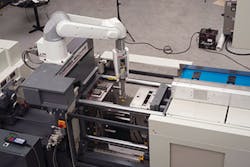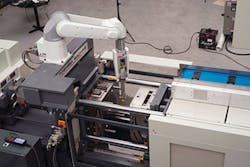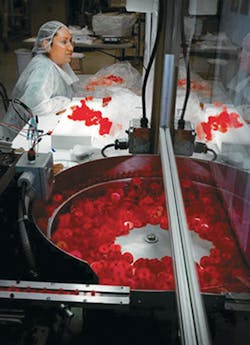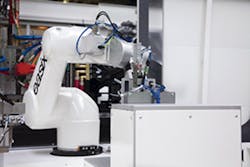Special Report: Use of robots, automation continues to grow
Customers are pushing manufacturers to innovate and evolve, contributing to changes in clean-room equipment. The rise in robots and automation is the most significant of a number of equipment trends, say some industry leaders.
Over the last five years or so, Ryan Guthrie, executive VP with TM Robotics (Americas) Inc., Elk Grove Village, Ill., has seen a significant increase in the use of robots in clean rooms, with robots becoming a requirement within much of the food and pharmaceutical industries.
Additionally, the functionality of the robots is increasing. "A trend that we're starting to see a lot more of is the six-axis robots working alongside the injection machines," Guthrie says. This reduces the number of operators and the inherent risk of contamination, as well as the cost, he says.
The use of automation overall — not just robots — is generally increasing. "We've always had some level of automation, but in the last four or five years, we've probably tripled the amount of automation we have," says Joe Vest, VP of engineering and logistics with injection molder Bright Plastics Inc., Greensboro, N.C. This increase includes equipment used in the clean room and elsewhere at the company. "The driver was probably cost, but it also does reduce movement," he says. With less traffic in and out of its clean room, the company can better restrict contamination.
The increasing sophistication of robotics also has contributed to growth. With new technologies, robots can be self-monitoring and self-correcting.
"The intelligence inside the machines is growing in leaps and bounds," says Guthrie. "If anything deviates from the norm, it can set off an alarm or self-correct. Having robots smarter and able to self-correct lends itself to less and less human interaction."
RENOVATION AND REDESIGN
Because clean rooms have been in use for decades, a number of companies are reaching the point at which their clean rooms need to be updated and revamped. This is not only
because the rooms and systems are becoming outdated, but also because companies are trying to repurpose them, says Matt Zelkovich, GM of medical for the Conair Group, Cranberry Township, Pa. "It is causing a lot of quality issues." For example, he says, "When I built pharmaceutical clean rooms, we put in systems to last for 10 years." Over that time, new technology has become available, and standards changed.
It is important to ensure that customers understand that technology will continue to evolve and improve, Zelkovich says.
INCREASING USE OF CLEAN ROOMS
The technology is particularly beneficial because Sands is seeing more molders integrating clean rooms into their plants, and those who already have clean rooms adding more. "There is growth across the medical industry toward innovative uses that weren't standard for medical devices and components," he says.
Dale Bartholomew, product manager with machinery distributor Maruka USA Inc. in Lee's Summit, Mo., has seen similar growth in medical clean rooms. "There have been a lot of customers adding on clean rooms because the medical market is very attractive because it is very stable," he says.
Engel provides machines for production of parts within the health-care and medical fields. Interest in these markets is heating up, says Christoph Lhota, VP of medical of Engel Austria GmbH, Schwertberg. "In the medical industry, all terminally sterilized products need to be manufactured under a controlled environment that is a clean room," he says. "As the medical device market is growing, the need for more clean-room space follows this growth." Though more clean-room space is required, the size of clean rooms doesn't directly track the number of parts plants can churn out. That's because higher-volume production is now possible in increasingly smaller cells.
"The lion's share of injection molding machines used in clean-room applications is taken by all-electric machines — and the figures are still rising," Lhota says. Two factors, in particular, explain the popularity of all-electric machines, he says. First, they are faster and more precise than similar hydraulic machines; and second, they are ideally suited to clean-room use, because they work without hydraulic oil, release less heat and keep particulate emissions to a minimum.
Industry experts expect clean rooms to continue to evolve to meet increasingly sophisticated demands from customers in markets such as the food and pharmaceutical industries.
"Automation can be expected to continue to advance as market forces demand it to do more and as robot technology evolves," says product marketing manager Claude Bernard, of Sepro Group, La Roche sur Yon, France.
Lisa Jo Lupo, correspondent
Contact:
Bright Plastics Inc., 336-668-3636, www.brightplastics.com
Conair Group, 724-584-5500, www.conairgroup.com
Engel Machinery Inc., 717-764-6818, www.engelglobal.com
Maruka USA Inc., 816-524-1811, www.marukausa.com
Novatec Inc., 410-789-4811, www.novatec.com
Sepro America, 412-459-0450, www.sepro-america.com
TM Robotics (Americas) Inc., 847-709-7308, http://tmrobotics.com



